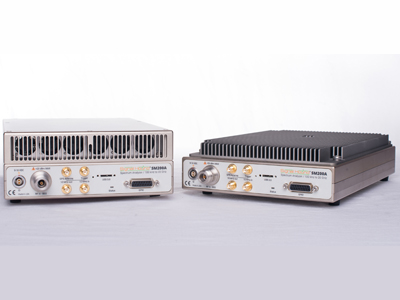Signal Hound has announced the addition of VITA 49 functionality to its SM200A 20 GHz headless RF spectrum analyzer and monitoring receiver.
The VME bus International Trade Association (VITA) 49 standard defines a packet-based exchange protocol for RF devices, such as spectrum analyzers and software-defined radio (SDR) receivers. The standard is intended to increase interoperability within RF systems by providing a communications format that is independent of hardware and supplier. Typical applications for VITA 49 are spectral monitoring and scanning, signal intelligence, radar, electronic warfare, direction finding and geo-location.
The latest version of this standard, VITA 49.2, defines the signal data and context packet types. Signal data packets consist of variable-sized blocks of I/Q data with a 32-bit trailer to convey critical information about the state of the receiver at the time the samples were obtained, such as timestamps and whether the system was overdriven. The context packets convey detailed information about the state and settings of the device at a given time. The context section is variable size, depending on how many of the available fields are used.
“The SM200A plays a critical role in diverse systems — we want to make sure that, no matter the architecture of that system, the SM200A speaks the language. Using the new VRT functions in the SM200A API, VITA 49 signal data packets and context packets help generalize data for integration in complex RF systems. This complements the SM200A hardware features, including 100 kHz to 20 GHz span, 160 MHz real-time bandwidth, 110 dB dynamic range, 1 THz/s sustained sweep speed and low phase noise, all in a cost-effective package. — Roger Rush, Signal Hound software engineer responsible for the new program feature
The SM200A's functionality offers several advantages:
- Greater context for signal data, including timestamps and system state change indicators.
- Status indicators for calibration to an external time reference, the stability of the time reference and invalid data, due to sample loss or over-range samples.
- Knowledge of system settings, including RF reference frequency, bandwidth, reference level, attenuation, sample rate, temperature, device identity and GPS geolocation.
- Increased compatibility with a wide range of RF applications.
The SM200A API’s capabilities include spectrum sweeping, setting record-on-event triggers, real-time analysis, I/Q data streaming and VITA 49 compatibility. Using a C interface, the functions are easily callable from popular language platforms such as C/C++, C#, Python, Java and MATLAB. The SM200A API manual and VITA 49 user guide provide full documentation of these features, and the software development kit (SDK) includes in-depth examples of usage in compilable C++ code, including a demo parser.
Availability
The SM200A VRT functionality is available immediately, at no cost, as part of the Signal Hound SDK, as a download from the Signal Hound website.

